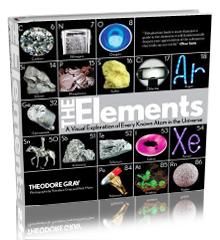Engine valve. | |||
| Sample Image | Spin Video | QuickTimeVR Rotation | |||
| Engine valve. This is an engine valve from a high performance car engine. A 90 degree wedge of the valve stem has been machined away (using a solid tungsten carbide end mill under a flow of water-free, petroleum-based cutting fluid), showing the hollow channel and its contents of sodium metal. The metal is solid now because the valve is cold, but because the melting point of sodium is quite low, it will liquefy as soon as the engine starts to warm up, and after that the sloshing of the liquid metal up and down in the hollow channel serves to transfer heat from the valve head (which is in contact with the exploding fuel in the cylinder) to the valve stem, which in turn transfers the heat further out of the engine. In this photograph the sodium is just slightly oxidized from exposure to the air, but when freshly cut under oil, it was bright, indicating a fairly high degree of purity. And when I dumped the collected metal chips (carefully) into a cup of water, they sizzled and popped, confirming that the contents of the channel really are sodium metal. After I finished taking pictures of this sample, I left it alone for the Thanksgiving long weekend, after which the sodium had oxidized further. It still had a coating of oil, and the air was quite dry, otherwise it would probably have converted entirely to oxide by then (sodium is extremely hygroscopic, and even with the oil and dry air, there was a good bit of highly alkaline liquid around the remaining metal). To make the sample safe, I needed to clean out the remaining sodium, which I decided to do by slowly exposing it to drops of water over the kitchen sink. This was not a good idea. Actually, I did pretty well with the valve itself, after I had used a fork to dig out most of the sodium: It sizzled quite a bit and the valve stem got warm, but I never let it get hot enough to actually catch the evolved hydrogen on fire. The problem originated with the few small clumps of sodium I took out with the fork. I put them on a paper towel, which was kind of dumb. Then I decided it was such a small amount, I would just run water over the towel and let them fizzle out. Needless to say, the paper towel caught fire and blobs (small ones, I should say in my defense) of flaming sodium popped in all directions including falling into the drain, where they made ominous echoing sounds as they filled the drain hole with smoke. OK, I admit it, I set the kitchen on fire with sodium. I, of all people, should know better! But it wasn't very much fire, and you are not going to tell my wife where the scorch marks on the floor mat came from. If you have any doubt that engine valves can actually contain sodium metal, let me assure you, they can. Source: Nick Brandenburg Contributor: Nick Brandenburg Acquired: 10 August, 2005 Text Updated: 29 January, 2009 Price: Donated Size: 5" Purity: >98% | |||
|

